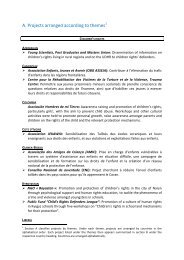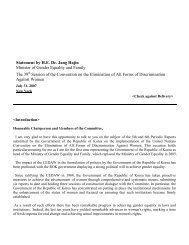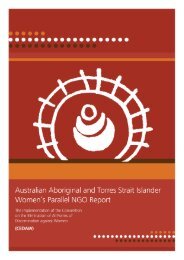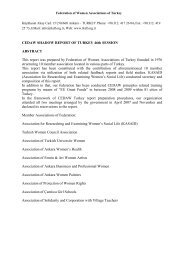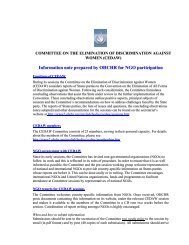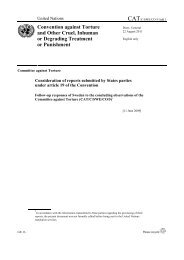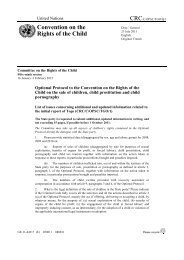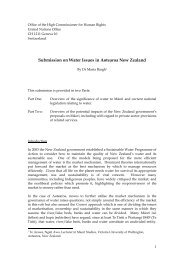Report - Office of the High Commissioner on Human Rights
Report - Office of the High Commissioner on Human Rights
Report - Office of the High Commissioner on Human Rights
- No tags were found...
You also want an ePaper? Increase the reach of your titles
YUMPU automatically turns print PDFs into web optimized ePapers that Google loves.
What has <str<strong>on</strong>g>the</str<strong>on</strong>g> Committee <strong>on</strong><br />
ESCR said about article 11(1)<br />
General Comment No. 4 paragraph 6:<br />
• The right to adequate housing applies to<br />
every<strong>on</strong>e. While references to “himself and<br />
his family” reflects assumpti<strong>on</strong>s as to gender<br />
roles and ec<strong>on</strong>omic activity patterns comm<strong>on</strong>ly<br />
accepted in 1966 when <str<strong>on</strong>g>the</str<strong>on</strong>g> Covenant was<br />
adopted, <str<strong>on</strong>g>the</str<strong>on</strong>g> phrase cannot be read today as<br />
implying any limitati<strong>on</strong>s up<strong>on</strong> <str<strong>on</strong>g>the</str<strong>on</strong>g> applicability<br />
<str<strong>on</strong>g>of</str<strong>on</strong>g> <str<strong>on</strong>g>the</str<strong>on</strong>g> right to individuals or to female-headed<br />
households or o<str<strong>on</strong>g>the</str<strong>on</strong>g>r such groups…<br />
Intersecti<strong>on</strong>al discriminati<strong>on</strong><br />
• Discriminati<strong>on</strong> against women can be compounded<br />
by discriminati<strong>on</strong> <strong>on</strong> o<str<strong>on</strong>g>the</str<strong>on</strong>g>r grounds such as race,<br />
disability, age, ethnicity, caste, sexual orientati<strong>on</strong><br />
and so <strong>on</strong><br />
• These discriminati<strong>on</strong>s may combine to create new<br />
forms <str<strong>on</strong>g>of</str<strong>on</strong>g> discriminati<strong>on</strong> against women eg<br />
– Sexual violence directed at women <str<strong>on</strong>g>of</str<strong>on</strong>g> a<br />
particular ethnic group<br />
– Forced sterilisati<strong>on</strong>s <str<strong>on</strong>g>of</str<strong>on</strong>g> indigenous women<br />
or women with disabilities<br />
– Forced evicti<strong>on</strong>s <str<strong>on</strong>g>of</str<strong>on</strong>g> widows<br />
Towards remedies: Small group<br />
discussi<strong>on</strong><br />
• Forms <str<strong>on</strong>g>of</str<strong>on</strong>g> discriminati<strong>on</strong> against women <str<strong>on</strong>g>the</str<strong>on</strong>g><br />
Pacific that prevent women’s enjoyment <str<strong>on</strong>g>of</str<strong>on</strong>g><br />
housing rights (from this morning’s sharing):<br />
Rural women in urban settings; Sexuality;<br />
Race/Ethnicity; Indigenous; Disability; VAW.<br />
• Which elements <str<strong>on</strong>g>of</str<strong>on</strong>g> <str<strong>on</strong>g>the</str<strong>on</strong>g> right to adequate<br />
housing are violated<br />
• What are <str<strong>on</strong>g>the</str<strong>on</strong>g> sources <str<strong>on</strong>g>of</str<strong>on</strong>g> this discriminati<strong>on</strong><br />
(e.g. law, custom, policy)<br />
• What measures need to be adopted to<br />
achieve women’s substantive equality<br />
N<strong>on</strong>-discriminati<strong>on</strong> and equality<br />
provisi<strong>on</strong>s in ICESCR:<br />
What model <str<strong>on</strong>g>of</str<strong>on</strong>g> equality is adopted<br />
• Article 2(2): The States Parties to <str<strong>on</strong>g>the</str<strong>on</strong>g> present<br />
Covenant undertake to guarantee that <str<strong>on</strong>g>the</str<strong>on</strong>g> rights<br />
enunciated in <str<strong>on</strong>g>the</str<strong>on</strong>g> present Covenant will be<br />
exercised without discriminati<strong>on</strong> <str<strong>on</strong>g>of</str<strong>on</strong>g> any kind as to<br />
race, colour, sex, language, religi<strong>on</strong>, political or<br />
o<str<strong>on</strong>g>the</str<strong>on</strong>g>r opini<strong>on</strong>, nati<strong>on</strong>al or social origin, property,<br />
birth or o<str<strong>on</strong>g>the</str<strong>on</strong>g>r status.<br />
• Article 3: The States Parties to <str<strong>on</strong>g>the</str<strong>on</strong>g> present<br />
Covenant undertake to ensure <str<strong>on</strong>g>the</str<strong>on</strong>g> equal right <str<strong>on</strong>g>of</str<strong>on</strong>g><br />
men and women to <str<strong>on</strong>g>the</str<strong>on</strong>g> enjoyment <str<strong>on</strong>g>of</str<strong>on</strong>g> all ec<strong>on</strong>omic,<br />
social and cultural rights set forth in <str<strong>on</strong>g>the</str<strong>on</strong>g> present<br />
Covenant.<br />
Discriminati<strong>on</strong> against<br />
women defined in CEDAW<br />
• Article 1: For <str<strong>on</strong>g>the</str<strong>on</strong>g> purposes <str<strong>on</strong>g>of</str<strong>on</strong>g> <str<strong>on</strong>g>the</str<strong>on</strong>g> present<br />
C<strong>on</strong>venti<strong>on</strong>, <str<strong>on</strong>g>the</str<strong>on</strong>g> term “discriminati<strong>on</strong> against<br />
women” shall mean any distincti<strong>on</strong>, exclusi<strong>on</strong><br />
or restricti<strong>on</strong> made <strong>on</strong> <str<strong>on</strong>g>the</str<strong>on</strong>g> basis <str<strong>on</strong>g>of</str<strong>on</strong>g> sex which<br />
has <str<strong>on</strong>g>the</str<strong>on</strong>g> effect or purpose <str<strong>on</strong>g>of</str<strong>on</strong>g> impairing or<br />
nullifying <str<strong>on</strong>g>the</str<strong>on</strong>g> recogniti<strong>on</strong>, enjoyment or<br />
exercise by women, irrespective <str<strong>on</strong>g>of</str<strong>on</strong>g> <str<strong>on</strong>g>the</str<strong>on</strong>g>ir marital<br />
status, <strong>on</strong> a basis <str<strong>on</strong>g>of</str<strong>on</strong>g> equality <str<strong>on</strong>g>of</str<strong>on</strong>g> men and<br />
women, <str<strong>on</strong>g>of</str<strong>on</strong>g> human rights and fundamental<br />
freedoms in <str<strong>on</strong>g>the</str<strong>on</strong>g> political, ec<strong>on</strong>omic, social,<br />
cultural, civil or any o<str<strong>on</strong>g>the</str<strong>on</strong>g>r field.<br />
Discriminati<strong>on</strong> against women<br />
defined in CEDAW (article 1)<br />
Note:<br />
• Acts <str<strong>on</strong>g>of</str<strong>on</strong>g> discriminati<strong>on</strong> can take a number <str<strong>on</strong>g>of</str<strong>on</strong>g> forms:<br />
“distincti<strong>on</strong>, exclusi<strong>on</strong> or restricti<strong>on</strong>”<br />
• It refers to discriminati<strong>on</strong> against women <strong>on</strong> <str<strong>on</strong>g>the</str<strong>on</strong>g><br />
ground <str<strong>on</strong>g>of</str<strong>on</strong>g> “sex” or “marital status” – sex<br />
discriminati<strong>on</strong> has also been interpreted to include<br />
<str<strong>on</strong>g>the</str<strong>on</strong>g> grounds <str<strong>on</strong>g>of</str<strong>on</strong>g> “pregnancy”, “breast feeding”,<br />
“widowhood” etc<br />
• It prohibits discriminati<strong>on</strong> in “effect or purpose” –<br />
whe<str<strong>on</strong>g>the</str<strong>on</strong>g>r indirect (unintenti<strong>on</strong>al) or direct (intenti<strong>on</strong>al)<br />
• The act <str<strong>on</strong>g>of</str<strong>on</strong>g> discriminati<strong>on</strong> must “nullify <str<strong>on</strong>g>the</str<strong>on</strong>g><br />
recogniti<strong>on</strong>, enjoyment or exercise by women … <str<strong>on</strong>g>of</str<strong>on</strong>g><br />
[<str<strong>on</strong>g>the</str<strong>on</strong>g>ir] human rights and fundamental freedoms”<br />
Discriminati<strong>on</strong> against women<br />
defined in CEDAW (article 1)<br />
Note fur<str<strong>on</strong>g>the</str<strong>on</strong>g>r:<br />
• CEDAW prohibits discriminati<strong>on</strong> against<br />
women in <str<strong>on</strong>g>the</str<strong>on</strong>g> private field – including<br />
discriminati<strong>on</strong> by “any pers<strong>on</strong>, organizati<strong>on</strong><br />
or enterprise” (article 2(e))<br />
• The CEDAW Committee has defined<br />
violence against women as a form <str<strong>on</strong>g>of</str<strong>on</strong>g> sex<br />
discriminati<strong>on</strong> (General Comment 19)<br />
Fur<str<strong>on</strong>g>the</str<strong>on</strong>g>r references to substantive<br />
equality in CEDAW<br />
• Article 2 (a) requires states parties to ensure<br />
<str<strong>on</strong>g>the</str<strong>on</strong>g> “practical realizati<strong>on</strong>” <str<strong>on</strong>g>of</str<strong>on</strong>g> equality between<br />
men and women<br />
• Article 3 requires <str<strong>on</strong>g>the</str<strong>on</strong>g> state to provide<br />
enabling c<strong>on</strong>diti<strong>on</strong>s that guarantee women<br />
are able to exercise and enjoy human rights<br />
<strong>on</strong> a basis <str<strong>on</strong>g>of</str<strong>on</strong>g> equality with men<br />
• Article 4 promotes affirmative acti<strong>on</strong> that<br />
accelerates “de facto equality” between men<br />
and women<br />
EXECUTIVE SUMMARY 79




